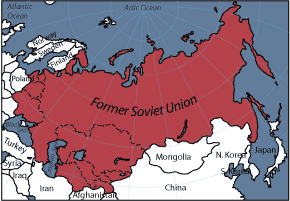The period of Joseph Stalin’s rule over the Soviet Union was significant in 20th century world history because of the distinctive character of the government, the extension of communism into Eastern Europe, and the increasing importance of the Soviet Union as a world power during the Cold War. Stalin’s rule of the Soviet Union began 1928, when, after a long struggle, he succeeded Vladimir Lenin, the unquestioned leader of the Bolshevik Party during the revolution, who suffered a stroke and then died in 1924. Stalin’s rule ended exactly 25 years later with his death in early 1953.
The Stalinist System
During this period, the following distinctive elements of the “Stalinist” system emerged:
- a one-party system in which the Communist Party controlled decisions having to do with political appointments, economic policy, cultural activities, and foreign relations;
- a personal dictatorship in which loyalty to a single leader, Stalin, had to be unquestioned and the image of the omnipotent leader filled public discourse;
- a pervasive system of police controls, forced labor, and violent repression that killed millions, imprisoned even more, and imposed restrictions on any kind of public speech, assembly, or organization;
- a system of forced modernization that transformed small-scale peasant agriculture into state-run collective farms and rapidly expanded industrial production by building factories, expanding mining, and developing transportation; and
- a foreign policy that sought to protect Soviet borders and Communist ideology through a combination of military power, as in the Soviet victory over Nazi Germany during World War II, and expanding protective borders by establishing loyal regimes in occupied Eastern Europe.
During the decade from 1929 to 1939, the foundation was laid for a system that transformed the Soviet Union, became the basis for extending communist influence into neighboring regions, and exerted a powerful influence on shaping world history in the 20th century.
Understanding Stalinism
An important way to understand Stalinism, both in the context of Soviet history and more generally, in 20th-century world history, is to ask about the impact of these elements on the population. While most studies of Stalinism concentrate on the biography of the leader, the establishment of the political regime, and the enforcement of a rigid ideology, this approach provides only a partial and somewhat distorted evaluation of the lived experience of this era. It is important to understand the ideology of the Soviet government and its uses of repressive mechanisms, but it is also important to find sources that provide information and perspectives that illustrate how people coped with dictatorship. Such an approach to aspects of everyday life—such as work, family life, and educational attainment—provides a way to assess both the systemic influence of political controls and threats and the constructive elements that allowed the Soviet people to function even in a repressive system.
Examining the lives of Soviet women provides an excellent way to consider these aspects of Stalinism. Soviet ideology declared that the “emancipation” of women was possible only in a socialist system, in which women were no longer treated as a kind of domestic property, in which educational and employment opportunities were offered to men and women equally, and in which women’s political involvement was actively encouraged. In 1917, women’s protests in anticipation of the socialist-designated celebration of International Woman’s Day had been one of the sparks that set off the Russian revolution. Throughout Soviet history, March 8 was recognized by the regime and the people as “International Communist Woman’s Day,” with rallies and speeches by political leaders, articles in the newspaper commemorating the achievements of individuals and describing the advances brought to all women, and, on a daily level, meetings in factories, in offices, and in neighborhoods in which women were given gifts and recognized for their contribution to the nation, to society, and to their families.
Women in Stalinism
Yet these propaganda claims did not fully reflect the complex situation of Soviet women during the 1930s. Women experienced all the most destructive elements of Stalinism as well. During the famine that followed collectivization, women suffered from the shortages of food, which posed a direct threat to their traditional role as family providers. The hardships of rapid industrialization and urbanization, including shortages of housing, lack of services, and other difficulties, were borne disproportionately by women even as they also coped with increased demands and requirements in their employment. While more men than women were killed during the most violent phases of Stalinism, such as the repression that accompanied collectivization, or the hundreds of thousands of summary executions during the “Great Terror” which peaked in 1936-1938, women were victims as well, as thousands were killed or imprisoned, while others dealt with the great burdens of losing fathers, husbands, or sons. Stalinism was an extremely destructive period of Soviet history, the implications of which bore more directly on the population and which had broader implications for 20th-century world history.
For the Soviet population, however, the 1930s were also a period of transformations in work, family life, household activities, and political involvement that inevitably combined “positive” elements with the “negative” consequences described above. More women entered the labor force and educational institutions, yet even as their numbers increased throughout the economy, proportionally they remained concentrated in certain fields, such as medicine, education, and domestic services, which were lower paying, less prestigious, and certainly not as politically influential. As millions of people migrated from villages to the rapidly growing cities, women found new opportunities for work, study, and leisure, even as those left behind in the villages had to bear an increasing share of the labor burden with even fewer resources. Finally, the ideological commitment to women’s equality and emancipation was not shared by all men, and on a daily level, women continued to encounter harassment, prejudice, and exploitation. By exploring these “everyday” aspects of Stalinism, these materials provide insights into the ways that Soviet women in particular, but the population more generally, coped with the demands and dilemmas of dictatorship.



